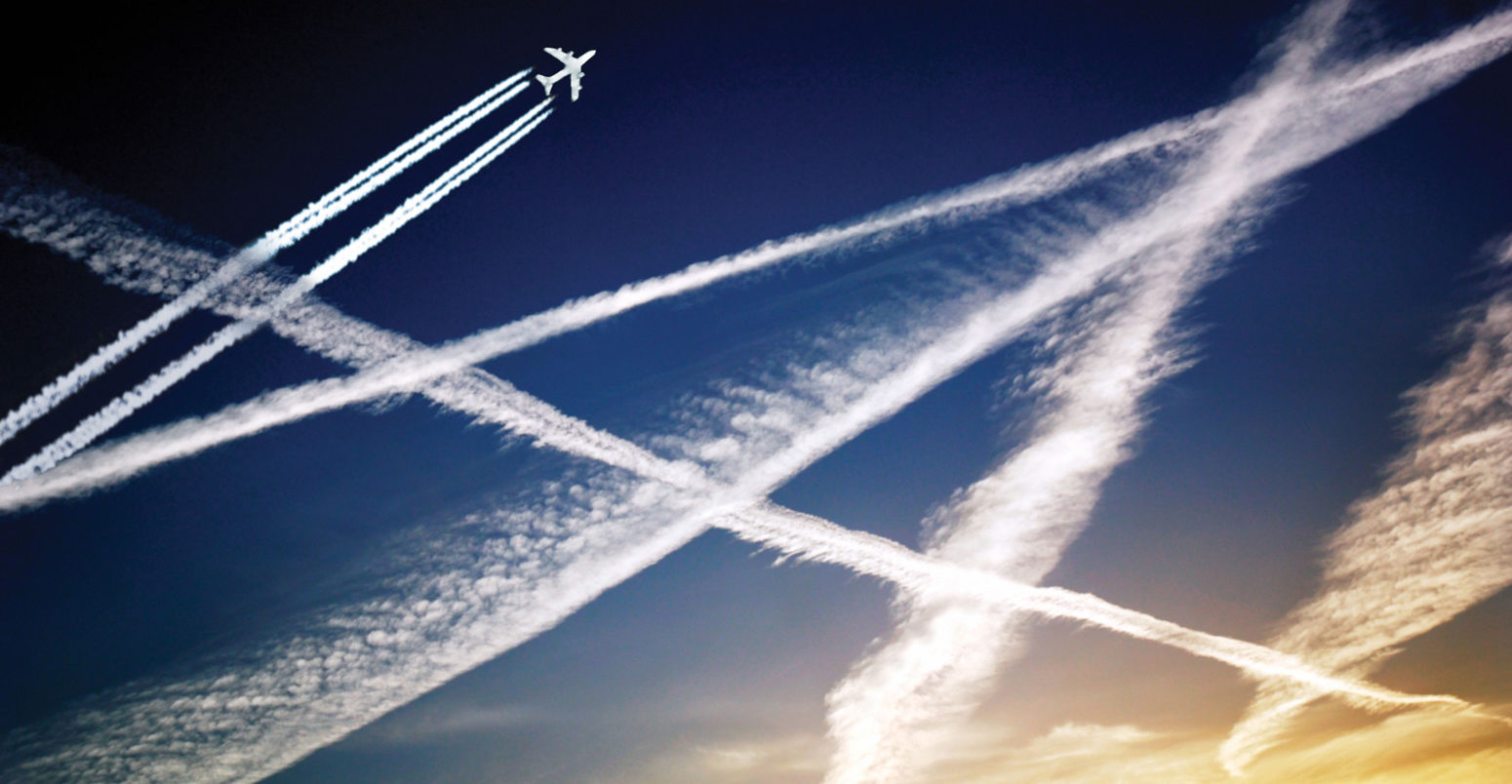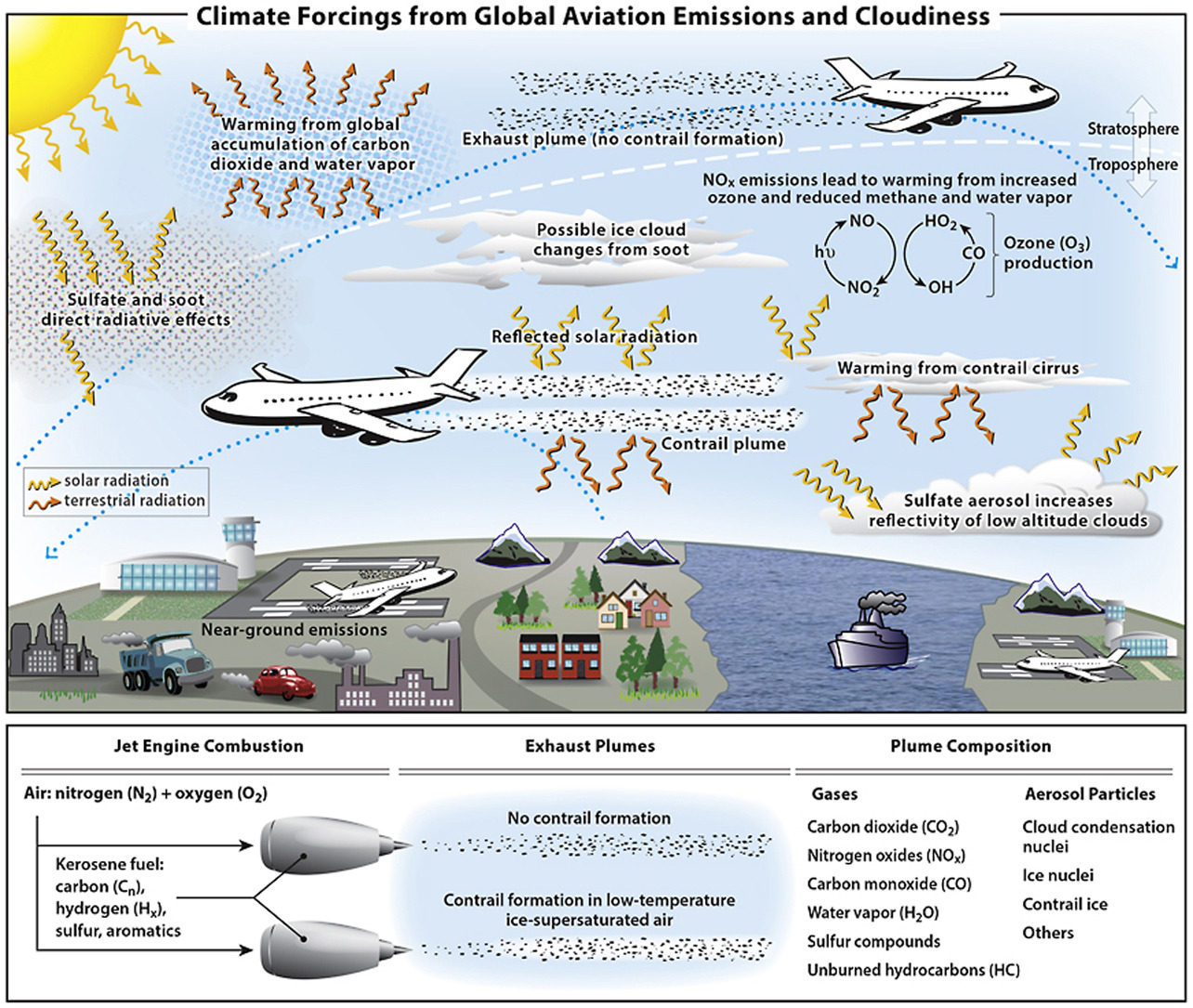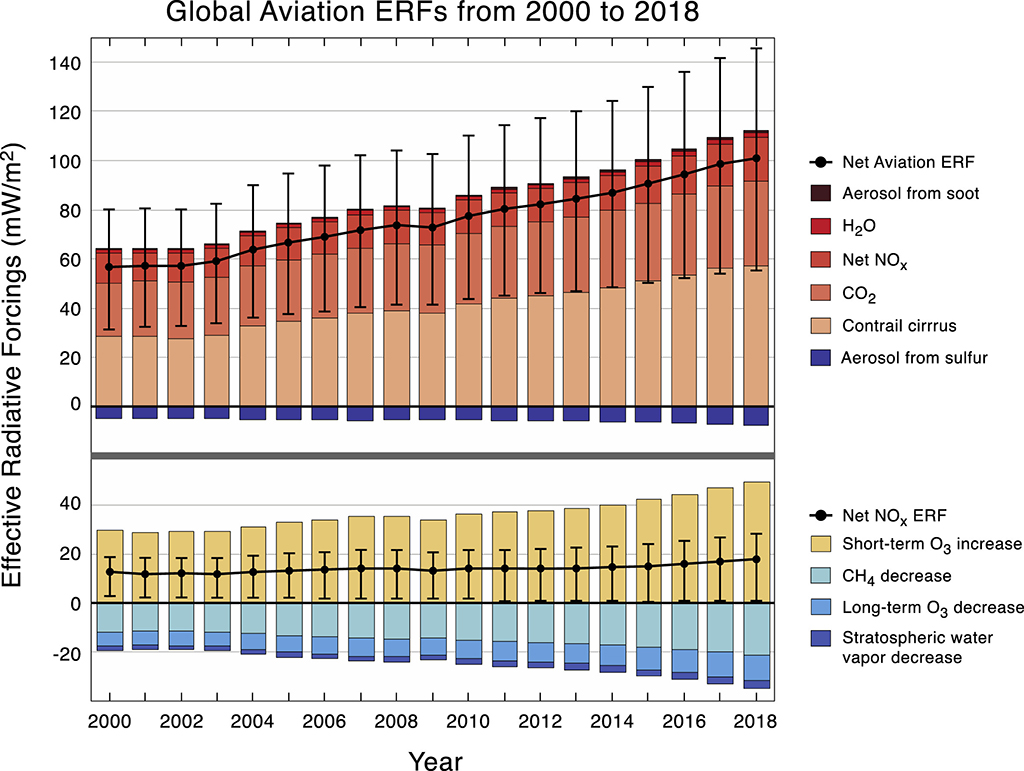
Guest post: Calculating the true climate impact of aviation emissions

Guest authors
09.21.20
Guest authors
21.09.2020 | 7:00amBefore the Covid-19 pandemic and its lockdown restrictions, air travel had become an almost unquestioned facet of modern-day life for many affluent nations and individuals – almost as much as the car.
Data for 2018 shows the global population flying more frequently – and over longer distances than ever before – with nearly 38m scheduled flights, carrying 4.3bn passengers over a total of 54bn km. Aviation has been growing at around 5% per year before 2020.
But what is the climate cost of all these flights? The oft-quoted figure is that aviation accounts for around 2% of global CO2 emissions. Yet, the impact of aviation on the climate goes beyond just CO2 and its emissions have complicated interactions in the atmosphere that can reinforce the warming impact.
Aviation’s climate impacts have been studied for many years, including a special report by the Intergovernmental Panel on Climate Change (IPCC) in 1999, but rarely are all the results pulled together to produce such a comprehensive analysis and assessment based on the best available science.
Published in the journal Atmospheric Environment, we – along with 19 other scientists around the world – recently produced an updated analysis of the present-day climate impacts of aviation.
We find that, when all its impacts are taken into account, aviation represents around 3.5% of the warming impact caused by humans in the present day.
Below, we unpack this headline result of the study and describe a little of the context.
Unusual sector
When estimating and attributing emissions, aviation is a somewhat unusual sector – 65% of its CO2 emissions (pdf) are in international airspace and, therefore, do not necessarily “belong” to individual nation states.
In addition, aviation has a large dependence on liquid fossil fuels, stringent safety regulations, as well as a long aircraft development and fleet turnover time. This means that rapid changes to the fleet – such as those being seen in motor vehicles – are simply not financially viable, let alone technologically feasible.
The international aviation sector was not included in the Paris Agreement on climate change. As a result, it is not addressed by individual nations in their pledges to reduce emissions, known as Nationally Determined Contributions. Yet, without tackling aviation – and shipping, another sector with international emissions – meeting the 2C or 1.5C warming limits of the agreement is made more difficult.
The aviation industry does have Corsia (“Carbon Offsetting and Reduction Scheme for International Aviation), a scheme agreed in 2016 by 192 countries through the UN’s aviation agency, ICAO. The aim of Corsia is to help the industry reach its “aspirational goal” to make all growth in international flights after 2020 “carbon neutral”.
However, Corsia has been subject to criticism, not least that, unless it is extended beyond 2035, the scheme will cover only 6% of projected CO2 emissions from all international aviation between 2015 and 2050.
CO2 effects
Despite the lack of coordinated international action, in order to address aviation’s climate impacts, it is still necessary to know what they are.
This is no small task, not least because the emissions from aircraft jet engines have a catalogue of direct and indirect impacts on the climate. These are summarised in the graphic below and we’ll tackle them in turn in the text below.

Aviation’s CO2 emissions are a relatively easy component to understand. Using historical data, we calculate that the total historical cumulative emissions of CO2 amount to some 32.6bn tonnes since 1940, nearly 50% of which were emitted over the past 20 years.
To put these emissions in context, they are ~2.4% of global emissions from fossil fuel combustion, cement production and land-use change (for 2018). Of course, cumulative CO2 emissions are what really matter, rather than an individual year, because of the long lifetime that CO2 has in the atmosphere.
However, aviation’s CO2 emissions are not the sector’s only climate impact – in fact, we calculate that they represent ~34% of the “effective radiative forcing” (ERF) of the sector.
(ERF is the imbalance in the Earth-atmosphere energy system since pre-industrial times and is measured in Watts per square metre. It is used as a metric of climate change to enable comparisons between different greenhouse gases and other impacts that affect the climate system – such as a change in albedo – as it has an approximately linear relationship with global average surface temperature change.)
The other 66% of ERF comes from non-CO2 impacts, principally from contrail cirrus and emissions of nitrogen oxides (NOx).
In addition, there are potentially large impacts of non-CO2 emissions from soot and sulphur, which form “sulphate aerosols” and affect both high-level and low-level clouds. However, the magnitude and even the sign of these impacts – whether they have an overall warming or cooling effect – is not totally clear based on current science.
Non-CO2 effects
Of these non-CO2 effects, the largest is from “contrail cirrus”. These are high-level clouds that can form from the archetypal contrails that aircraft leave in their wake.
Contrail cirrus clouds form when water vapour in the atmosphere condenses onto soot particles kicked out from an aircraft’s jet engines. When the temperatures are cold enough – typically -30C or lower – clouds of ice crystals form. If they are persistent, these ice crystals can spread from line-shaped structures into large thin sheets of cirrus clouds, high in the atmosphere at cruising altitudes of aircraft (around 8-12 km high).
These clouds cause cooling by reflecting solar radiation during the day and also warming by trapping outgoing infrared radiation. However, they have an overall warming signal, lasting up to around 18 hours (and an average of eight).
The second largest non-CO2 effect on climate from aviation is from NOx emissions. NOx is created by the aircraft jet engines from the combination of atmospheric nitrogen and oxygen. The high pressures and temperatures of the engines make conditions almost perfect for NOx formation – such that reducing NOx emissions is a major engineering challenge.
NOx emissions play a role in the formation of another greenhouse gas, ozone (O3), which is not directly emitted, but is formed and destroyed in the atmosphere by highly complex chemistry.
And it gets more complicated still. NOx emissions result in an increased level of the hydroxyl radical, OH. These are highly reactive molecules that destroy methane in the atmosphere. As methane is a potent greenhouse gas, its destruction by hydroxyl radicals has a cooling effect.
Aircraft emissions also cause reductions in water vapour in the stratosphere and more general background ozone, which represent additional smaller cooling responses. However, in sum, the forcing from aircraft NOx has a warming effect.
Finally, there are also rather small additional non-CO2 impacts from the direct emissions of water vapour and soot, which have a warming impact, and a cooling effect from sulphate particles that are formed from the emission of sulphur dioxide from trace amounts of sulphur in the fuel.
Overall impact
The charts below illustrate the different emissions from aircraft and their wider impacts between 2000 and 2018.
The upper chart includes all of these impacts. The red bars of different shades highlight that contrail cirrus and CO2 are the two principal warming impacts of aircraft emissions, with smaller contributions from NOx and soot. Aerosols formed from sulphur (blue bars) have a small cooling effect.
The black line shows the overall warming impact of aviation when all of these effects are taken into account. This warming impact has increased from around 56m W/m2 in 2000 to 101m W/m2 in 2018.
All together, aviation represents around 3.5% of present-day radiative forcing. Thus, even though it accounts for around 2% of CO2 emissions, its impact on the climate is much larger.
The lower chart unpacks the specific impacts of NOx, including the warming caused by the short-term increase in ozone (yellow bars), the cooling (blue bars) caused by destroying methane, long-term decline in ozone, and a reduction in stratospheric water vapour.
The uncertainties in the estimates for the climate impact of aviation (shown as error bars) is dominated by non-CO2 emissions. It should also be noted that some effects cannot yet be quantified – including aerosol-cloud interactions of sulphur and soot emissions – and these effects remain a scientific priority.

Air travel after Covid
While we have estimated the impact of the global aviation industry on the climate in recent years, 2020 will likely look very different.
But what will be the long-term impact of the Covid-19 pandemic on air travel? We did not consider future pathways within our study, but Covid restrictions have shown how quickly travel behaviours can change.
Currently, there are industry forecasts that imply a range of recovery rates over the next few years and that, ultimately, the sector’s traffic may return to pre-Covid levels – and, thereafter, continue to increase.
Unless things change after Covid, the recent restrictions will not make a large difference on aviation’s CO2 impacts. It is cumulative CO2 that matters rather than a single year’s emissions – and as traffic recovers, the non-CO2 impacts return.
If aviation recovers and continues to expand as previously, aviation emissions could grow to become a dominant portion of human emissions as other sectors decarbonise.
Alternatively, corporations might find it unproductive and expensive sending their workers to business meetings now that video conferencing options have become embedded in daily life. Similarly, with many holidaymakers eschewing international travel in favour of domestic destinations, regional tourism could become an increasingly popular choice.
The aviation sector itself is calling for more investment to recover and decarbonise. However, unless measures to limit fossil fuel usage are also introduced, the sector will remain incompatible with the Paris ambitions.
Lee, D. S. et al. (2020) The contribution of global aviation to anthropogenic climate forcing for 2000 to 2018, Atmospheric Environment, doi:10.1016/j.atmosenv.2020.117834
This article represents the views of Profs Lee and Forster and not necessarily those of the paper’s co-authors.
-
Guest post: Calculating the true climate impact of aviation emissions
-
Guest post: How aviation emissions contribute to climate change

